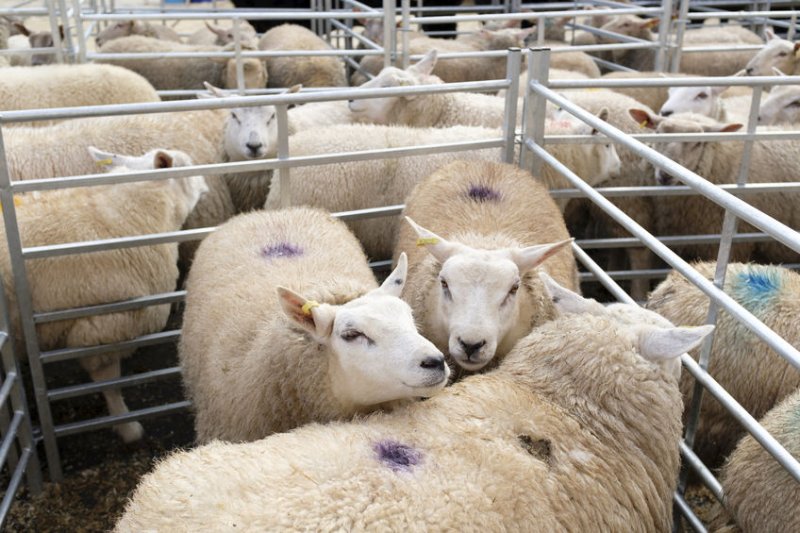
The final week of May has seen prime sheep prices fall at Scottish auctions following Ramadan which ended on 23 May, according to the latest market commentary.
New season lambs fell by 5% to 249p per kilogram in the week to 27 May and old season prices were 11% lower at 187p/kg.
There was also a downwards trend through the week, with prices slipping towards the 240p/kg mark, Quality Meat Scotland (QMS) said in a new update.
Nevertheless, prices continued to average higher than last year, by 6 percent for new and 8 percent for old.
In 2019, new season lambs had traded at around 240p/kg in the first half of May before sliding towards 230p/kg in the second half.
“Ramadan came to an end on 23 May with the Eid al-Fitr festival,” said Iain Macdonald, senior economics analyst with QMS.
“As a result, processors were looking to secure additional sheepmeat supplies in the period leading up to it, providing a boost to market prices in mid-May.
“A clear demonstration of the impact on sheepmeat demand from the festival comes from the market being able to absorb increases in the combined total of new and old season lambs of 29% on the week and 34% on the year,” he added.
At Scottish auctions, the strength of demand in the week to 20 May saw auction prices for new season lambs edge higher to average 262p/kg, which was a 13% increase on the same week of 2019.
Meanwhile, old season lamb prices were 12 percent higher than last year, averaging 210p/kg.
Cull ewe prices were also affected in mid-May, although they appear to have taken an earlier lift than prime sheep prices, jumping back above £80 a head in the week to 13 May despite a rise in marketings.
A more significant lift in sales in the following week then saw prices dip back towards £70.
According to Mr Macdonald, now that the peak in demand has passed, the market has rebalanced in line with a traditional seasonal pattern, with prices softening despite the reduction in total prime sheep marketings.
Focusing on 2020-born lambs, they accounted for two-thirds of prime sheep marketings at GB auctions in the week to 27 May.
In Scotland, the later lambing season means that while numbers have been rising considerably each week, jumping by another 57% in the week to 27 May, they still accounted for only a third of the total.
In comparison with 2019, over the four weeks to 27 May, new season lamb numbers rose by 15% across Great Britain.
In Scotland, an even stronger rise has been accompanied by a significantly higher proportion of these lambs weighing in the Standard Quality Quotation weight range of 25.5-45.5kg.
“There was also a 1% increase in sales of old season lambs across GB from 2019, purely driven by Scottish marts,” said Mr Macdonald.
“With farmgate prices remaining higher than last year throughout the month, this does signal some demand-side strength.”
A weekly indicator of GB retail sales based on data from Kantar indicates increased spending on lamb relative to 2019 in recent weeks due to the re-balancing of demand from the catering sector into retail.
However, an average year-on-year increase of 7% in weekly sales between the beginning of April and mid-May was more modest than the overall lift in retail spend on food and drink of 19%.
Looking at exports, demand is reported to have been firm of late, having previously collapsed in March.
In France, the lamb market rebounded in April and has stabilised this month, with no sign yet of downwards pressure since the end of Ramadan.
“Across many EU countries, the slow re-opening of the catering and foodservice sector may have been helping support demand for UK sheepmeat,” added Mr Macdonald.
“Meanwhile, a weakening of sterling is likely to have helped support export competitiveness, with a euro now buying around 89-90p, compared to 87-88p from early April to mid-May.”
On the import side, while imports from New Zealand picked up in March as product was diverted from China due to logistical issues there in February, Beef + Lamb NZ have since reported renewed declines in shipments to Europe.
“Looking forward, with a stable breeding flock reported in December, good weather through the spring is suggestive of a small increase in lamb crop,” said Mr Macdonald.
“However, the outlook for demand remains uncertain with domestic retail sales showing relative weakness and only a slow recovery in demand from the catering sector anticipated.”
According to Mr Macdonald, trade prospects look a little brighter as limited progress on UK EU trade talks may keep sterling weak, unless an unexpected extension to the transition period is agreed by the end of June.
“In addition, although slow, the reopening of the foodservice sector is moving faster than in the UK,” said Mr Macdonald.
“Meanwhile, early marketing in NZ due to drought and targeting of the Chinese market is likely to limit imports.”
